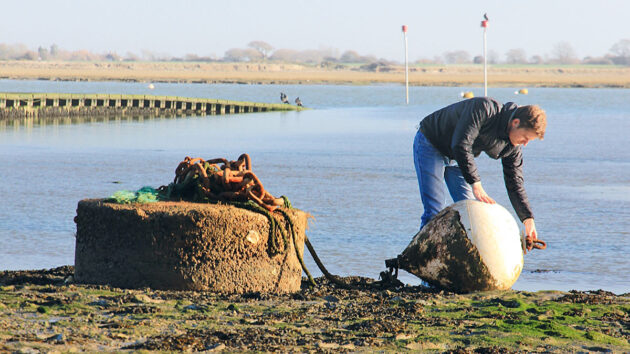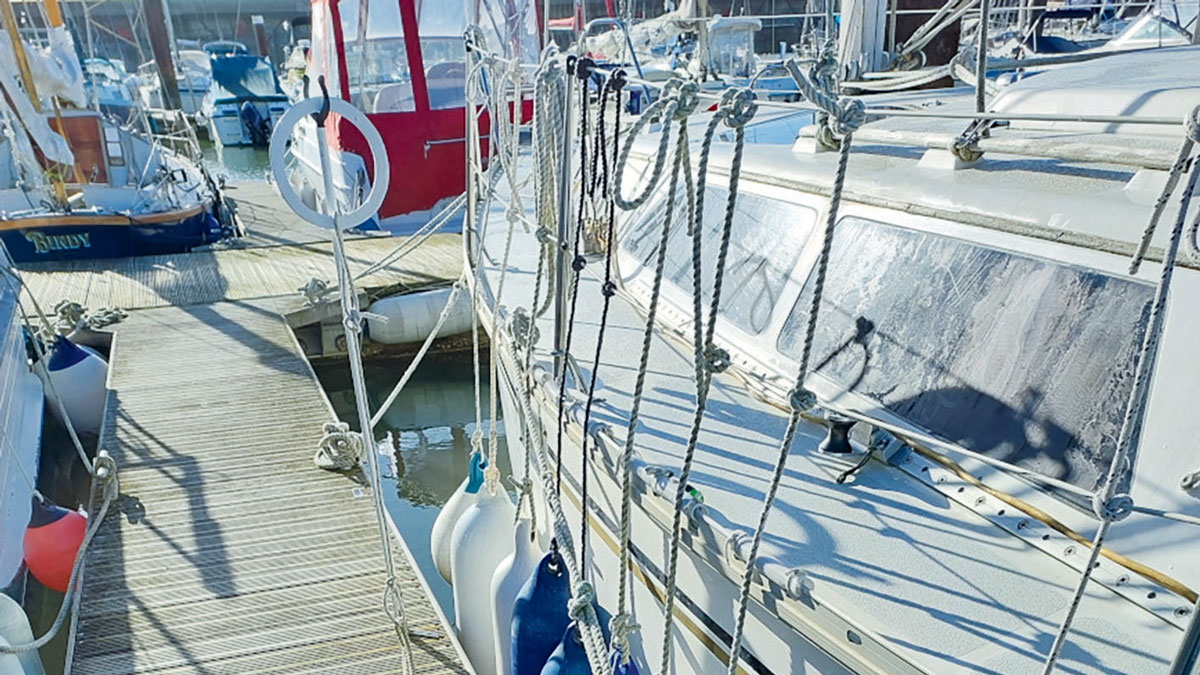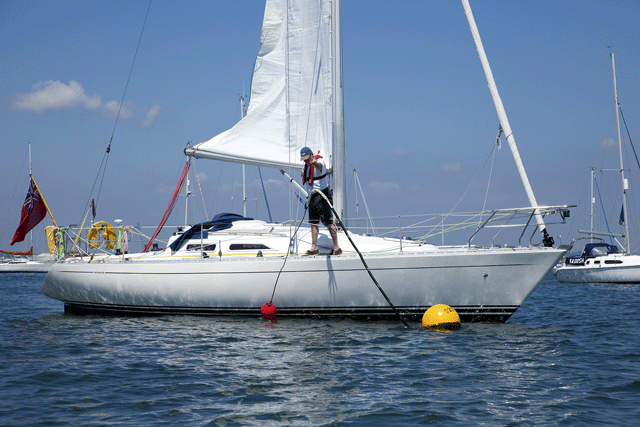Most sailors use traditional moorings without knowing about their condition or how they are made. Ben Sutcliffe-Davies explains how to carry out checks and what to look for
Most navigable estuaries are lined with traditional swinging moorings, and they’ve filled up many of our anchorages, too, but can you trust the mooring you choose?
Some skippers view moorings with suspicion, preferring to trust their own anchor or to tie up alongside every night, but most of us use them, either as visitors or as long-term residents.
It’s easy to inspect the top part of a mooring when you pick it up and it’s wise to do so, but what about the parts that you can’t see through the murky water?
They all look the same at the buoy, but there are many different ways to make up a mooring tackle and many conflicting opinions among experts as to how it should be done.

These moorings and their sinkers have been hauled above the low water mark for checking and servicing over the winter. Credit: Theo Stocker/Future
Local knowledge is important. I grew up in a boatyard in Suffolk where the top reaches of the rivers dry out to various types of mud at low water and where it’s crucial to ensure the boat can’t be damaged by grounding on top of her mooring tackle.
Strong ebb tides, varying depths and shifting sands can complicate it further.
As a yacht surveyor and cruising skipper, I’ve encountered many different types of moorings around the British coast.
It’s worth knowing a bit about them, and here’s what you need to know.
Boatyard or fairway committee?
Many boatyards have been in the moorings business for generations, under long-standing fairway agreements.
They lay their own moorings and rent them out, often on a seasonal arrangement, and the owner of the river bed – usually the Crown Estate – gets a percentage of the takings.
A boatyard mooring is the least-hassle type because an annual service of the tackle is normally included, and you can expect it to be fit for purpose for the agreed size and draught of your yacht.
It’s always worth checking with the office at the start of the season that your mooring has been serviced prior to your using it.
Moorings run by fairway committees are often oversubscribed because they tend to be cheaper than boatyard moorings, with long waiting lists.
When that letter of allocation finally arrives, it can feel like winning the lottery – but it usually comes with strings attached, so read the terms and conditions.

When picking up a mooring you can’t check its condition underwater. Credit: Graham Snook/Future
In most cases, you are completely responsible for laying appropriate mooring tackle to hold your yacht at the designated position on the chart, without hindering others.
A fairway committee may also stipulate what type of mooring tackle you are expected to use.
Often, this stems from local knowledge of what does and doesn’t work on a particular type of river bed.
Or it may be that space is tight and they need to ensure that adjacent boats are moored the same way so they don’t swing into each other.
Some fairway committees insist on being notified if you are away for more than a few weeks, so the mooring can be sub-let.

Always ask permission before you borrow a private mooring. Credit: Richard Langdon/Ocean Images
Disputes about liability can occur if a boat drags or breaks a sub-let mooring.
If there’s any doubt, it’s worth ensuring your mooring is serviced before you sail away for the summer, if only for peace of mind.
Most fairway committees require each mooring to display a clear number, and some people paint on the buoy the maximum size of boat it can handle.
This can be helpful, but could also land you in hot water if a visitor picks it up and it then fails.
I know a few folk who declare that their mooring is only suitable for a Wayfarer dinghy!
Can I lay my own mooring?
If you are responsible for laying and maintaining your mooring, think very carefully before deciding to do it yourself.
In most cases, it’s extremely difficult without specialist equipment, including a good work boat and a barge on which to lay out the tackle with a winch capable of lifting more than a ton.
If you try doing it from a yacht or a large dinghy, you’re likely to damage the boat. It’s far more sensible to pay a professional to supply and lay the ground tackle.
If you do use a contractor, make sure they have insurance coverage to undertake the job as instructed.
Some yacht clubs lay moorings for their members in self-help working parties, which is a great way to learn how it’s done.

Typical sinker mooring set-up
The components that make up a typical mooring tackle include a sinker or anchored ground chain, a riser, a swivel, several shackles and a buoy on a pick-up line.
Let’s start at the bottom. The simplest way to hold a mooring in place on the sea bed is to use a large weight, called a sinker.
This is generally how it’s done, except where moorings are very close together and their scope (swinging room) is critical.
A sinker can be almost anything. I’ve seen old tractor wheels, a load of 56lb weights shackled together, even old engine blocks – but it’s usually a concrete block with some scrap chain inside it and a couple of 40mm rings coming out of it, or a run of heavy-gauge chain.
Experts disagree about the ‘correct’ shape of a sinker, if its underside should be slightly hollow to create suction and where the chain or ring should be positioned.
Some say in the middle, while others put it near a corner or side. I preferred the latter, laid in the ebb tide orientation.

A ground anchor should have only one fluke to avoid snagging on the mooring’s riser. Credit: Ben Sutcliffe-Davies
Our reasoning came from a few incidents when moorings with central rings skidded across the river bed in a strong ebb.
When the chain was run from the side of a sinker, if it did start dragging, it often got pulled down into the riverbed.
Where moorings are laid in shifting sand or very soft mud, the sinker often gets swallowed up, and when it needs servicing, it may be impossible to recover.
That’s why I like to run a length of heavy chain from the sinker to well above low water springs – just in case.
Where moorings are tightly packed, fairways committees often require the use of two anchors on a large ground chain, instead of a sinker.
The riser can be shorter, reduced to the depth at high water springs plus a few feet.

Typical ground chain mooring set-up
Some committees also stipulate the direction in which the tackle must be laid. It’s important to prevent the riser from tripping out an anchor on the turn of low water and to ensure the boat’s keel can’t ever make contact with a ground anchor.
The rule of thumb from my own experience is that the ground chain should be twice the length of the yacht plus the scope of riser and another 10ft for safety.
In some areas, ground chains are laid across the tide with one anchor deep in the fairway and the other replaced by a stake, placed at low water springs.
There are a few obvious problems: the chain gets worked a lot more with each tide; there may be only 15 minutes of slack water in which to lay the mooring; and there may be a risk of the boat drifting over the stake as the tide ebbs away and impaling herself on it.
But the most common problem is when a visiting yacht drops anchor, not knowing where the ground chains are. They get fabulous holding when their anchor fouls your ground chain…
When moored boats collide
A trot is a line of moorings that share the same long run of ground chain, with an anchor at each end.
The ground chain, if heavy enough, does most of the work while the anchors act as pins.
Boats on a trot must be reasonably compatible. I can vividly remember one boatyard that laid trots and put all sorts of different boats on them, the result was a very busy workshop that summer, after a strong wind-over-tide day when deep-keeled yachts lay to tide while quarter tonners and lift-keelers zipped around like demented speedboats on a leash!
In some places where moorings are very crowded, they use fore and aft risers so the boats are prevented from swinging.
Regardless of what’s on the sea bed, the riser is very important.

Heavy bits of scrap metal are sometimes used as sinkers, like this old steel wheel. Credit: Ben Sutcliffe-Davies
Most old-school boatmen would run a chain the whole way up, but it’s expensive, and steel is not what it was – recycled material in steel has definitely caused some chains to fail after just a few seasons of use.
Most moorings have a heavy chain running up from the ground chain or sinker to the level of low water springs, then either a lighter chain or a rope from there to the top.
This makes it a lot easier to haul the whole lot up at low water springs for checking and servicing.
All-rope and part-rope risers are on the increase.
A heavy, good-quality, pre-stretched three- or four-strand nylon warp will last longer and help keep the boat pointing in the right direction, though not as effectively as chain.
Where rope is connected to the chain, it’s vital to use proper thimbles to stop the rope from chafing on the shackle.
Using a bow shackle reduces wear on the thimble, too. The splicing needs to be neat and also whipped, to prevent any chance of being unwound.
Don’t use any rope that floats. It could take a turn around the keel at low water – boats have been known to break their moorings that way.

Even steel chain risers need checking annually. This one is badly pitted. Credit: Ben Sutcliffe-Davies
The scope of a mooring with any sort of sinker must be carefully considered.
Ideally, the riser’s length should be two to three times the depth, depending on what it’s made of, the tidal range and, importantly, the strength of the tidal stream.
Swivels are often the weakest link. They’re turned under load four times a day and can wear quite quickly.
You’ll need a good, large one in the right place.
I’ve had to deal with horrible messes where the swivel has seized and the riser has wound itself into a ball, becoming so tight at high water that it has overloaded the stem fitting of the yacht.
I like to put the swivel at the top of the riser so no matter what the tide does, grit or mud can’t get easily packed into the wearing surfaces.
When making up mooring tackles, I always used the largest swivel I could physically fit to the chain and pass a shackle through.
As with chain, the quality of steel used in shackles is key.
When buying, ensure the pins fit snugly through the chain you are using.
You may need two shackles to connect a heavy ground chain to a lighter chain riser. The shackle should fit snugly, but not so snug that it can get wedged.
The shackle pin should fit snugly, and its thread mustn’t be too coarse. This is very important.
If it’s badly cut, when tightened, the thread will be stripped off the pin.
After tightening, use a hammer to seize the thread so it can’t turn back, and wire or a cable tie to seize the pin.
Buoy suitability
There are many types of mooring buoy. One popular type has a part-threaded metal bar through the buoy that serves as a swivel, with a ring eye on one end and a seized nut on the other.
On the whole, they are very reliable, but a few models need careful checking at least annually.
The other drawback is that the boat can surge or pitch onto the buoy and strike the metal bar, scratching and chipping her gel coat.
A common problem with mooring buoys is that they get submerged at high water or dragged under when the tidal stream is strongest.

The metal parts of a mooring buoy can cause extensive damage to a boat’s topsides, so ensure that they can never make contact. Credit: Ben Sutcliffe-Davies
If this happens, the buoy isn’t big enough. So, before you buy one, check that it has enough buoyancy to support the weight of the whole riser, plus a bit more, and check it when the tide is running hard.
Attaching small cork floats further down the riser can keep the buoy afloat, but they can complicate things and will increase the wear on a chain riser.
Use a pick-up buoy on a length of line instead. Finally, a word about borrowing private moorings.
Always ask first. If there is nobody to ask, don’t use it except perhaps in a real emergency when there’s no other option.
Even then, you’re taking a risk –you don’t know how strong it is or when it was last serviced – and above all, you must stay on board in case the owner comes back.
How to check, service and maintain a mooring
It’s bad practice to check a mooring by motoring hard astern – and very bad manners if it belongs to somebody else! That includes visitors’ moorings.
If you’re unsure about them, ask the harbourmaster rather than fiddling with them yourself.
You can check your own mooring most of the way down to the sinker or ground chain, either from a big dinghy that you don’t mind getting scratched, or from the yacht’s foredeck.
Either way, take great care and do it at low water springs. You’ll learn through experience how often the mooring needs to be checked.
A good look at the start of the season, before it’s used, is essential. I’ve dealt with claims that arose when a boat was put on a mooring that was due to be serviced the following week.
A mid-season check is sensible, and it’s worth doing again at the end of the season.
If ice is expected over winter, attach extra floats, and if the riser is rope, ensure it can’t be cut.
On the upper reaches of the river where I worked, we used to take the mooring buoy off completely and use a light chain with fishing corks on a line tied to a large wooden log and a lobster pot cork float and flag from December to early March.
Swivels – the weakest link?
The swivel needs regular checks because its working surfaces can wear quite quickly. If possible, apply waterproof grease.
If the riser is rope, check for damage along its full length as well as at the ends.

Mooring swivels are under constant load, holding the weight of the riser chain. Credit: Ben Sutcliffe-Davies
If you have a mooring buoy with a swivel, check that carefully for wear, too. If it has a threaded bar with a nut, sometimes the threads are hammered or spot welded; occasionally, the threads can corrode, and the nut will get pulled off!
Also, check the bar that runs through the buoy – it might well be mild steel with a plastic coat.
Make sure every shackle is seized and any splices are whipped so they can’t get unwound. Thimbles must also be well fitted.
Believe it or not, there are anode blocks available to hang on your riser. Given the poor quality of mild steel these days, it’s worth a try.
I’ve seen massive galvanic pitting in high-carbon steel chains.
Insurance issues and considerations
Most insurance companies consider moorings to be slightly higher risk than marinas, so they will charge a bit more and expect it to be properly checked.
Even if you’re confident you can do this yourself, it’s important to confirm your insurer is happy for you to do so.
Take photos as evidence that the tackle is kept in good condition, and to document your maintenance and checks.
If you hire the mooring from a third party, ensure your agreement with them states that they’re responsible for providing a suitable one, and for checking its condition.
Lastly, be aware that most underwriters only cover boats on moorings for ‘the season’, so ensure you know when that season starts and finishes.
Swinging mooring setup: What I learned from trying a cheaper mooring option
After almost two decades of being marina berthed and concerned with the ever-increasing mooring fees, myself, and my partner, Brian,…
How to make an easy marina mooring pick-up device
Jon Sharp devises an easy marina mooring pick-up using a hoop on a pole
How to sail off a mooring
In many situations, leaving the mooring under power is the only sensible option. But if conditions allow, why not spare…
Best boat rope – the right rope for mooring lines, halyards and sheets
At this time of year we often start to put into place plans for upgrading our boats for the new…
Want to read more articles?

A subscription to Practical Boat Owner magazine costs around 40% less than the cover price.
Print and digital editions are available through Magazines Direct – where you can also find the latest deals.
PBO is packed with information to help you get the most from boat ownership – whether sail or power.
-
-
-
- Take your DIY skills to the next level with trusted advice on boat maintenance and repairs
- Impartial, in-depth gear reviews
- Practical cruising tips for making the most of your time afloat
-
-
Follow us on Facebook, Instagram, TikTok and Twitter








